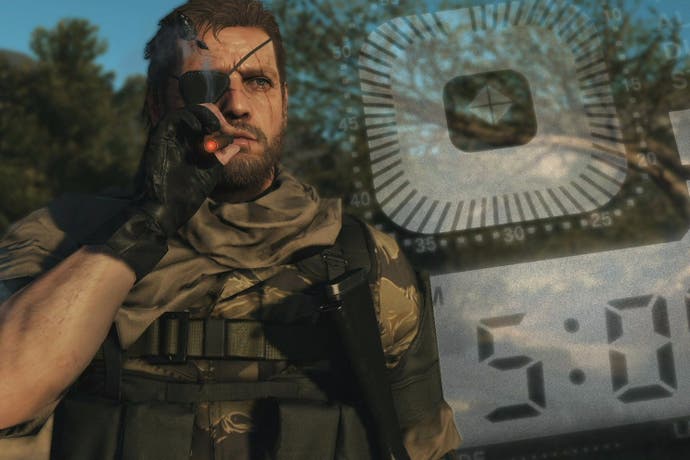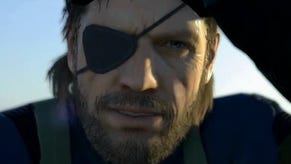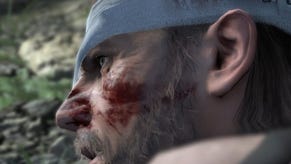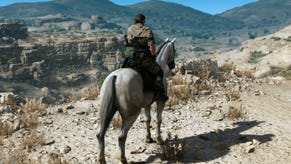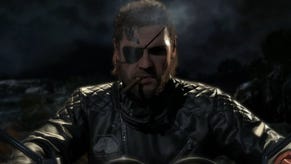Metal Gear Solid 5: The Phantom Pain review
Living the dream.
Metal Gear Solid 5: The Phantom Pain is a dream game. It's the kind of game that, in 1987, the young designer of the 8-bit Metal Gear may have dreamed would one day be possible. It's the kind of game that players like me dream of: an enormous and deep and seemingly endless experience that's worth the investment and then some. It's the kind of game where every hand-polished element slots together into a head-spinningly ambitious structure and they combine into something you can only call visionary.
Metal Gear Solid 5 transplants the stealth core of the series from linear environments into large open worlds, banking everything on great enemy AI and numerous moving parts that allow players freedom of approach in any given situation. The idea is not a completely new one to Metal Gear Solid. Since Metal Gear Solid 3, Kojima Productions has been designing environments around open principles, and in The Phantom Pain the enormous increase in scale comes with a smart caveat: you deploy to main missions by helicopter, and to a more limited zone of operations, which allows for custom layouts.
The two main locations, Afghanistan and Zaire, can be explored end-to-end, and one of The Phantom Pain's great pleasures is riding around taking care of side ops as you go. You drop into locations by chopper but from then on it's either foot or horse, and more often than not the roads are no-go areas. Wildlife scatters as you press through trees, herbivores graze bushes and vultures circle lazily overhead. The transitions from night to day can change everything, casting light into dark crevices and silhouetting things moving on high ground. Most other open worlds go for scale, but Metal Gear Solid 5 goes for density and intimacy, and its world feels alive. Travelling a kilometre is never just a matter of sprinting in a line, but of accounting for passing patrols, impassable terrain, brightly-lit or open areas and fortified positions.
A good early example is a long, heavily guarded bridge that needs crossing. You can sneak around, taking out guards one-by-one, but then the ones at the other end of the bridge will see you crossing. So you can snipe them, or distract them, or try to lure them. Then there's a whole underside of scaffolding to explore, too. And if all else fails, why not just go down into the basin and try some rock climbing? I must have spent hours at this bridge: lazily memorising the sentry routines, kidnapping and interrogating guards, clambering up and down the undersides, finding every stash of materials and eventually riding away with the location picked clean. Metal Gear Solid 5's systems - on their own, absent of any direction beyond 'get from A to B' - can make something like crossing a bridge thrilling. These kind of bespoke set-ups are at the heart of why The Phantom Pain is so special. It is an open world that, when it needs one, has a director.

Not that you're able to ignore his presence. Any fears that creator Hideo Kojima's public spat with publisher Konami would lead to a lessening of credit are dismissed as his name appears on the screen constantly. He's not alone either, each mission beginning with a credit-laden intro that becomes as familiar as the opening to your favourite show. It's always exhilarating for the moment when Big Boss pops the door of his chopper open and at once the unmuffled noise of the rotors fills your ears, the landscape stretches out wide, and you wonder what's waiting.
Big Boss is a fearsomely capable protagonist, and in this more heavyset incarnation really feels like a legendary soldier at his peak. The wide range of melee animations are minimalist masterpieces of brutality, while his extensive movement repertoire allows you to cope with uneven terrain, dense camouflage and spatially complex settlements. Everything centres on avoiding enemy vision.
One of the reasons Metal Gear Solid 5 is such a superb game is that it goes so far towards realism, or simulation, but settles on a point just before either that allows for maximum flexibility and entertainment value. Unless you're firing an unsuppressed weapon or sprinting around like an idiot, guards generally won't spot movement over 50 metres away outside of completely open terrain. This allows you to get within reasonable distances - at which point they become much more dangerous, after a cautious but not boringly long-winded approach. Sometimes they seem a bit blind, but the tradeoff in keeping the pace of infiltration high is worth it.
The same goes for the new addition of Reflex mode, which triggers super slow-mo the instant Big Boss is spotted. You have a few seconds, moving his aim ever-so-slowly, to line up the perfect headshot and take the guard out before the alarm is raised. Reflex mode is another anti-simulation mechanic, but it's so gorgeous I can't imagine Metal Gear Solid 5 without it. It's capable of creating amazing last-gasp moments, three seconds of action after 20 minutes of sneaking that can leave you trembling with excitement.
Reflex mode can't always save things, of course, and the best feature of the enemy AI is how individuals work together once your presence is detected. Taking out isolated soldiers is relatively easy, but when clustered together they watch over each other effectively, stepping up their personal caution if they see something weird, and immediately radioing in anything that's a definite tell. The environment that hides you so well does the same for them, and if they know you're around, they'll make use of it.
If you're spotted, it's terrifying, simply because it's often fatal and has consequences. Metal Gear Solid 5 saves regularly, but checkpoints are based on objectives - you can spend half an hour playing and then be reset, though you keep resources and certain items found. This means you never want to die, and avoiding death once you're spotted is a challenge. Big Boss has regenerating health, but not much of it, and enemy soldiers are witheringly accurate over large distances.
As you develop better weapons it becomes possible to play Metal Gear Solid 5 as a shooter when this happens - and a good one, because even here the AI manages to keep up. Enemies will begin to be equipped with gear that counters your favourite weapons and, once you're spotted, begin rushing the position with riot shields and shotguns. It's a rare pleasure to play against enemies that are so consistently surprising, capable both of dishing out pain and using their numbers against you in smart ways.

Even if fighting can be amazing, and you later acquire all manner of suppressed offensive gear, it never feels like your first option. Metal Gear Solid 5 really becomes a game about control as much as stealth: mastering layouts and patrol paths and the semi-intelligent enemies and unpicking them in the manner you please. I like grabbing enemies from dumpsters, pulling them around corners, holding them up, and piling their bodies in the road for trucks to stop at (so I can nick the truck). I like attracting clusters together and then dropping a stun grenade and running in like Batman. When guards are in Alert phase, you lose control over their behaviour in this sense, and it seems to me this is where the fun is.
There are so many wonderful toys. The vanilla decoy is great enough, a frisbee-like disc you toss out and can then trigger to make a sturdy balloon of Big Boss appear - enough to attract a nearby guard into thinking he's making the arrest of the century. But it's when you get the audio decoy, which plays clips of Kiefer Sutherland saying "kept you waiting, huh?" and "you're pretty good," that things go off the charts. You can set these up in a small ring, pop one, attract a group of guards over, then pop the others one by one and send the guards on top of them flying. Then send your dog over to fulton their prone bodies while countless Big Boss clones repeat their lines.
The decoy is one item, and your HQ Mother Base has hundreds to manufacture: all manner and make of pistols, rifles, SMGs, snipers, shotguns, grenade launchers, rocket launchers, and mechanical arms, with different functionality across ranges, customisation options, huge differences in handling and cost, and lethal/non-lethal options. There's a cornucopia of grenades alongside mines and remote explosives and spy gear and new suits and buddy equipment and innumerable one-off oddities like the capture cage for trapping small wildlife or the bait bottle for attracting carnivores. You won't even believe the types of cardboard box you can start developing.
These tech trees are magnificent, but merely one strand of the all-encompassing Mother Base - the centre of Metal Gear Solid 5's structure and the focal point for the player's long-term engagement. Mother Base is essentially an army that Big Boss is building, and a continuation of one of the best aspects of Metal Gear Solid: Peace Walker, though it makes its implementation in that game look like a dry run. In Peace Walker, Mother Base was a basic 3D model and a series of stat screens. In Metal Gear Solid 5 she still has a bunch of menu screens, but on top of this is now a physical repository for everything the player has achieved. Men walk the decks and salute as you walk by, the very sight of your legendary figure raising morale. The animals you 'rescue' from the battlefield are stored in a ludicrous but brilliant oil platform zoo, which has a definite Animal Crossing insect collection vibe. And as you begin collecting up vehicles and armaments for the battlefield, preparing for the online invasions to come, you see them beginning to dot key parts of the structure. You are building a living monument to your journey as Big Boss.
The Mother Base structure works so well because Metal Gear Solid 5's world is a perfect fit for a collector's mindset - every player has an avaricious side and, in a place as lovingly detailed as this, having the freedom to steal things means you're going to steal everything. While Metal Gear Solid 5 is first and foremost a stealth game, the presence of the fulton extraction system gives it a whole other dimension. This device lets you airlift KO'd enemies to Mother Base, where they become your troops, and eventually upgrades allow lifting stationary weapons, vehicles, and even shipping containers.
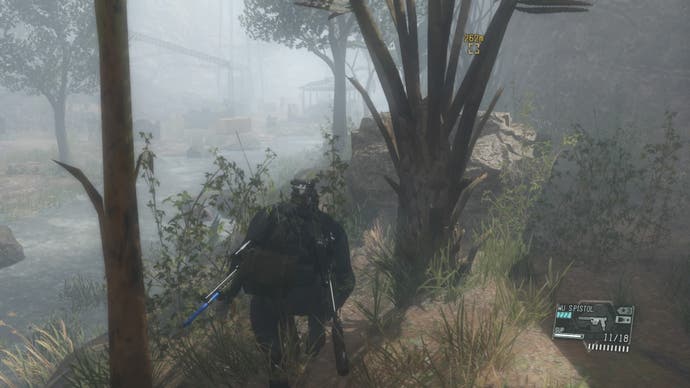
When my fultons became capable of stealing most things in a base, my play-style changed completely. The efficient and deadly spy of the early hours was gone, replaced by an obsessive non-lethal thief who disappeared every single guard and piece of weaponry from any outpost he came across. And, let's not kid ourselves here, Metal Gear Solid 5 is designed very much for people who love collecting stuff. The soldiers are good enough, with the added spice of their individual 'skill' specialities, but once you start collecting the wildlife too, there's no end in sight. The other day, my legendary soldier spent 20 minutes trying to nail one damn eagle that wouldn't land.
The optional online component of Metal Gear Solid 5, built around base invasions, has only started today - we'll go into detail a little further into its lifespan - with the collectibles feeding into it. As a player, this kind of integration is a delight. I love collecting stuff in this game so much I spent hours in Afghanistan just riding about nicking things rather than doing missions, and nearly bankrupted my Mother Base - lifting off scores of Jeeps at 10,000 GMP recovery cost apiece.
These slightly straitened finances are another improvement over Peace Walker. In that game you had enough money to do almost everything all the time, but in Metal Gear Solid 5 cash isn't quite so plentiful - you have to prioritise certain weapon and item paths, and make do in other respects. When you throw everything into non-lethal gear as I did when I was in fulton thief mode, and then run out of money just as enemies start using much tougher protective gear, you have to re-think where the money's going. You'll have everything eventually, of course, but making the GMP feel like it's worth something gives even minor choices a consequence.
The cherry on the cake, now that Metal Gear Solid has the perfect structure for its systems, is that Kojima has finally learned how to tell a story. If Metal Gear Solid 4 was some sort of nadir in Kojima's not-unblemished narrative career, The Phantom Pain is where he finally gets it right. The cut-scenes are much shorter and snappier, with the same high production values, and all of the extra period detail and digressions that Kojima so loves are set aside in cassette tapes. The leap in voice talent doesn't hurt either, with Troy Baker's Ocelot in particular a master of the two-minute monologue.
Ground Zeroes suggested a more mature direction for Metal Gear Solid's world and - though mechs and seemingly supernatural villains still feature, of course - that's borne out here. But old themes also return in a new way.
One of the first things you discover upon visiting Zaire is child soldiers. In Metal Gear Solid 2, Kojima made the lead character Raiden a child soldier, and referenced this in a few codec calls, but in Metal Gear Solid 5 you are on the battlefield looking at 10-year-old boys with rifles. It's the difference between showing and telling, and one hell of an uncomfortable moment. Kaz tells you not to kill them, but they won't hesitate to kill you. It feels utterly wrong to be sneaking around these kids, never mind tranquilising them, and their yelps of terror when they discover you or a knocked-out friend are awful. Some of them, if surprised, instantly drop their guns and surrender rather than trying to fight. It is great to see a war game with the confidence to present rarely mentioned horrors in such a straightforward way. And, crass as I feel pointing this out, the theme also works as great system design: child soldiers are enemies you can't engage with 'normal' tactics.
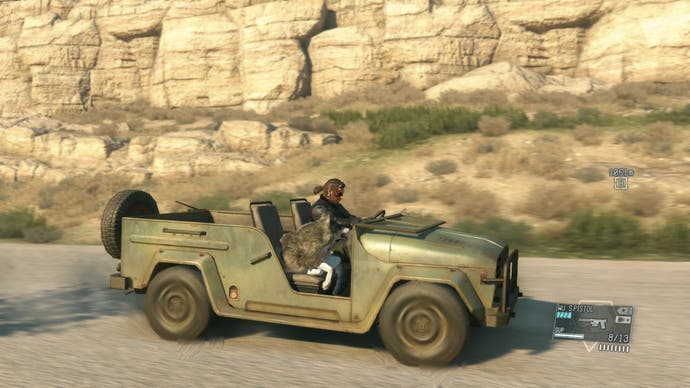
Metal Gear Solid 5's world is much more cynical and grounded than that of the other games, with Ocelot's weary frankness a window on the machinations of East and West. The mix of real history and fictional Metal Gear Solid elements can sometimes be hard to disentangle, but leads to a rich context that unspools as you explore and re-explore. Atop this is the main narrative arc, which is where all the crazy stuff happens: flaming men, assassins that can warp and pull guns out of thin air, psychics, Skullface, and of course giant mechs. There's little point in unpacking it all other than to say this: Metal Gear has always been a military series, but unlike, say, Call of Duty, it has never been a series in thrall to the military. In Metal Gear Solid 5 it uses this theme as a setting to go to more interesting and dark places than ever before.
The more fantastical side is where the boss battles come in, which find Kojima Productions going for substance over style. There are several major sniper battles, not simply to pay homage to Metal Gear Solid 3's famous The End, but because this setting is already perfect for sniper battles - and Metal Gear Solid 5's mechanics suit them better than ever. Your first encounter with this game's giant mech is a winner, a stealth-based cat-and-mouse chase over the foothills and cliffs where the cat is equipped with Gatling guns and search robots. Individual set-piece encounters with humans, like the White Mamba, introduce clever one-off twists on close combat. And even when Metal Gear Solid 5 descends to the level of a straight-up battle, as with some of the Skulls encounters, the shooting mechanics are now so polished that it's still a pleasure.
The thing is, the bosses don't matter that much anymore. It's an old rule-of-thumb for judging how good a game is, and they're great, but Metal Gear Solid 5 throws so much old thinking out of the window. This series is special because it has always been able to renew itself across the hardware generations, making new styles of game constructed on the same principles.The Phantom Pain marks the ultimate expression of this, alongside the ultimate structure to contain it.
Metal Gear Solid 5: The Phantom Pain is not just a high watermark for the series. It is the greatest ever stealth game by a distance, a true masterclass from a designer and team who bow out at the very peak of their creative powers. This is one of the greatest blockbusters our medium has ever had as well as the perfect ending to one of gamings' great series - and the end of one incredible, extended journey from Hideo Kojima. For decades to come, players will see the legacy of Metal Gear Solid, and have no choice but to salute.
